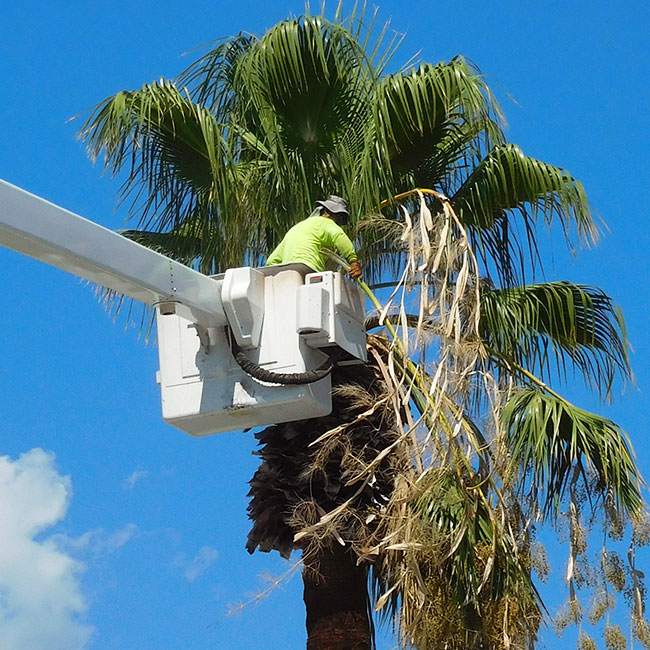
Trimming palm trees is far simpler than trimming other broadleaf trees. All you have to remove are dead leaves and old fruit stems. Palms with crown shafts make it even easier by shedding brown leaves on their own. Just pick up the dropped leaves and dispose of them.
Palms usually maintain a certain amount of leaves at all times. Each leaf has a life cycle which starts with the leaf emerging from the middle of the palm known as the bud, and ends after a while with the leaf turning yellow, brown, and finally falling off.
As the old leaf dies, the palm moves its nutrients to the newer fronds. While palms with yellow and brown fronds might look unattractive, it’s best to remove them only after they have turned completely brown. By cutting them off too early, you will take these nutrients away from the tree.
How Many Palm Leaves Should You Remove
There are a few different types of cuts. To avoid over pruning I always recommend following a Natural Cut or so-called 9 to 3 Cut.
Here is a picture of an untrimmed Date Palm. It has old dying leaves at the bottom and healthy green leaves emerging from the top.
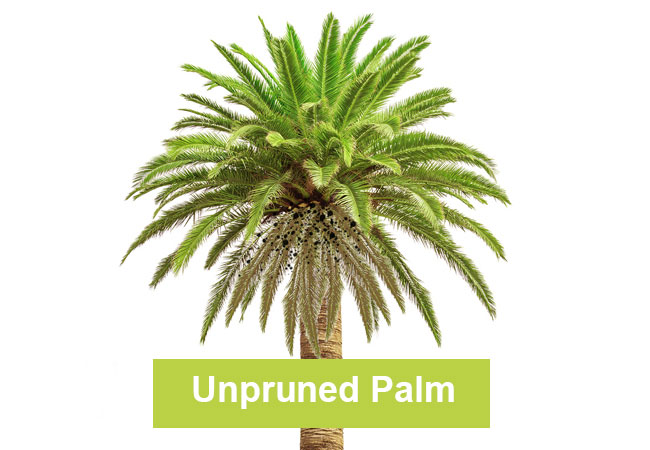
Natural cut is when you trim only the dead fronds leaving all the green leaves untouched. Notice that old leaf bases near the top have been trimmed in a beautiful diamond pattern.
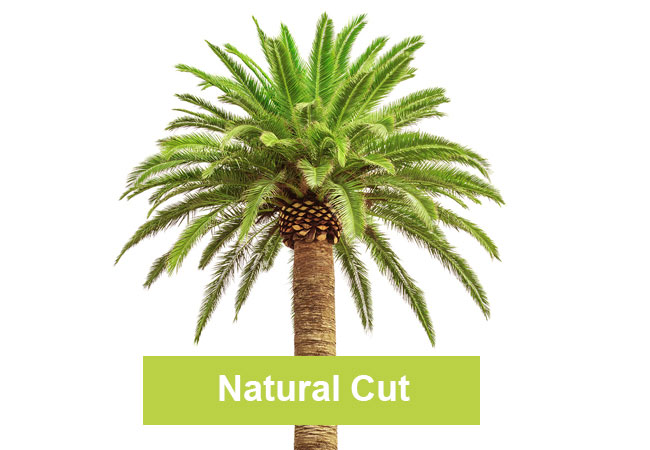
The 9 to 3 cut is when you put the hands of the clock on 9 and 3 and then remove all the fronds below that. Basically, the leaves would be parallel to the ground. This is the most popular cut that most palm owners use. It’s still healthy and leaves plenty of fronds.
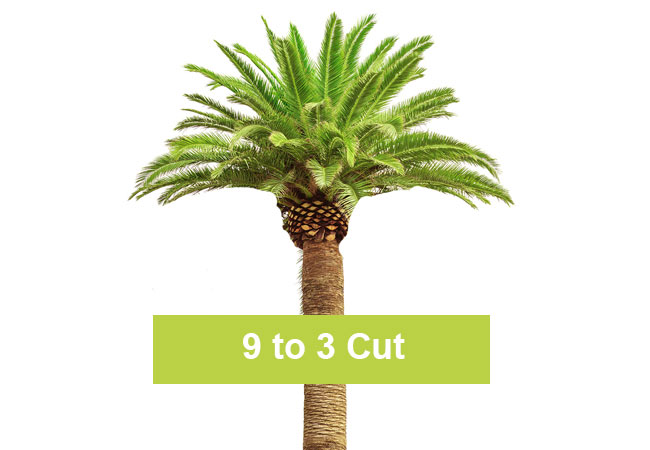
The 10 to 2 cut is when you put the hands of the clock on 10 and 2 and then remove all the fronds below that. Palms with this type of cut are considered to be over-pruned.
Many landscapers use this cut to lessen the frequency between trimmings so they have to do it only once a year instead of multiple times a year.
This is a very harmful practice because even though some of the fronds have some yellow in them they are still very essential for the palm. If your palm has been over-pruned, provide it with extra fertilizer to compensate for lost nutrients.
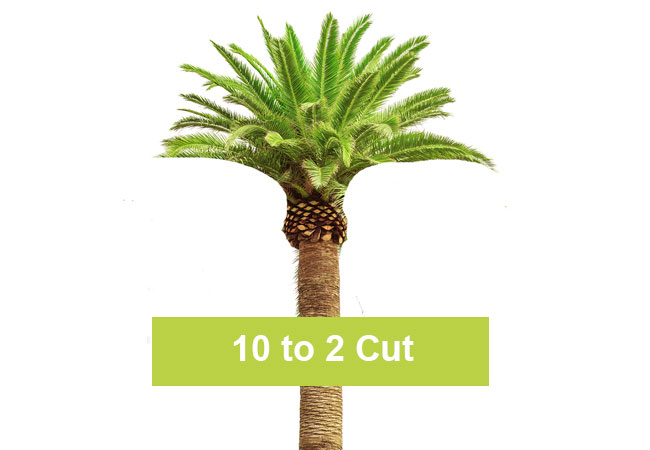
Hurricane cut is what some of the homeowners do to prepare for a hurricane. Only a few fronds are left. This is the worst kind of cut you can do. It robs the palm of most of its food and sends it into shock. DON’T do a hurricane cut.
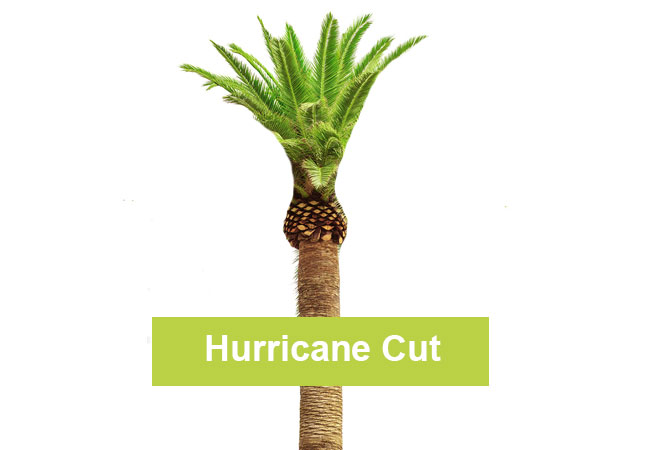
How To Trim Palm Tree Leaves
When removing a leaf, cut it as close to the trunk as possible. The remaining leaf base eventually falls off, but it may take several years. If you try to strip the leaf base from the trunk before it is ready to fall off, you can scar the trunk.
In some species like Date palms, you create an interesting pattern on the trunk by cutting the leaf stems at a uniform distance from the trunk.
Palms with crown shafts like Royal Palm, or Foxtail Palm are self-cleaning. They shed dead leaves so there is no need to prune them. However, sometimes you might want to remove a dying leaf to create a cleaner look.
When removing old leaves from palms with crown shafts, see if the leaf base can be easily pulled from the crown shaft. If it doesn’t, leave it in place and just cut off the leaf as close to the trunk as you can.
Pulling that leaf base before it is ready to fall might harm the palm. You can remove it later when it begins to turn brown or just wait for it to fall on its own.
On younger palms, when cutting bottom fronds, try to cut as close to the trunk as possible. However, as you get higher on the trunk, leave about 1/2 inch or 3/4 inch space from the trunk because on younger palms the growth of the trunk is still expanding, and cutting too tight might disturb trunk development.
When there are multiple trunks, be careful not to cut the green leaf coming from the other direction from the tree next to it. Follow the brown leaf to the trunk to make sure you are cutting the right one. Cut below the last set of spines (if there are spines on the stem).
Palm Tree Hurricane Pruning
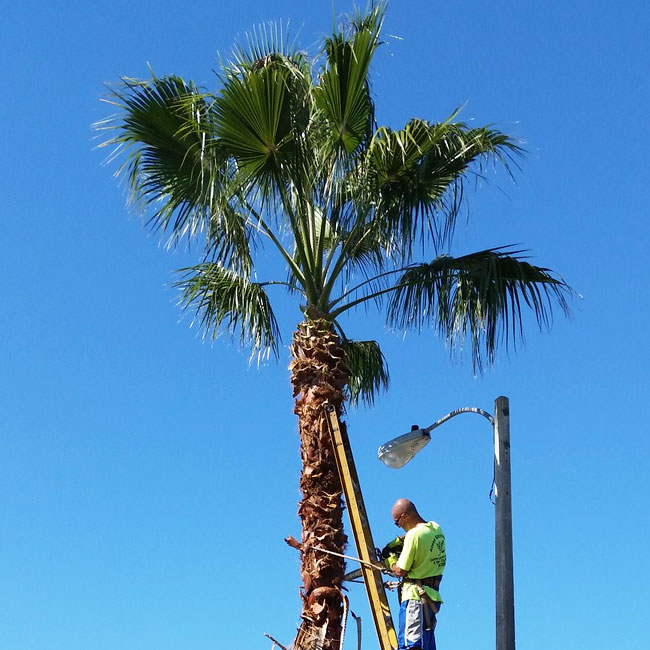
Because hurricane cut is such a big problem throughout the coastal areas, it deserves its own section. Some tree trimmers that have nothing else to do, offer hurricane cut, a technique that could be fatal to palms.
This type of service has gone on for so long that many palm owners don’t realize how harmful it is to the plant.
Most palms are very wind-resistant and don’t get damaged as severely by high winds. Yet, many still believe that trimming off most of the leaves will help the palm to survive a hurricane.
On the contrary, severe leaf removal weakens the crown to the point that it may snap off even in moderate winds. Severe trimming also stresses the palm making it more susceptible to insect infestations and diseases.
If you want to trim the palm in preparation for a hurricane, trim off only those leaves that hang below the horizontal plane of the crown. This practice retains a sufficient leaf crown to maintain the health of the tree.
More severe pruning can harm the palm. Before trimming it again, allow the palm to grow a complete ball-shape crown. Also, don’t forget to fertilize trimmed palms regularly. This will guarantee an adequate amount of nutrients to compensate for nutrients removed with the trimmed leaves.
Best Palm Tree Pruning Tools
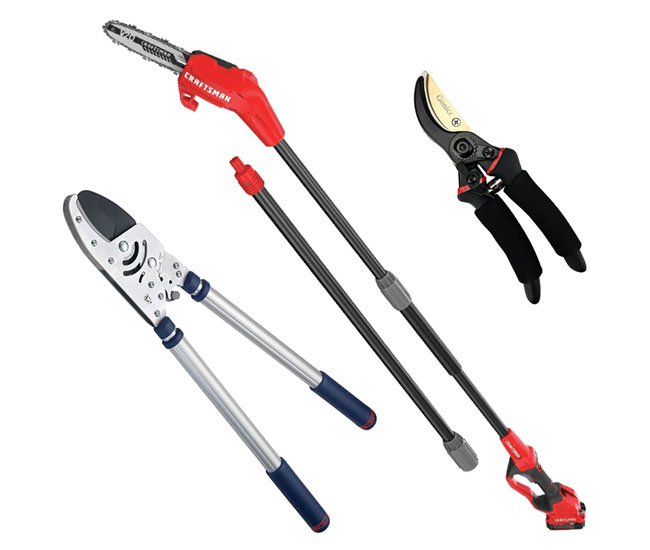
The tools used for pruning palms are also very simple and easy to find. You can use a regular utility knife to cut small palm fronds and flower stalks.
Hand prunes are great on smaller palms while ratchet lopper/lopping shears work well on palms with larger fronds. When using hand pruners, always cut the stem with the blade facing up.
A telescoping pole saw works great on taller palms that you can’t reach with the hand pruner or lopper. There is also an electric pole saw that is perfect for high-up fronds. You can reach branches that are 20ft high without using a ladder.
To help prevent the spread of diseases such as fusarium wilt, treat your pruning tools with alcohol or hydrogen peroxide after each palm. You can also use household bleach to disinfect the tools.
How to Trim a Tall Palm Tree
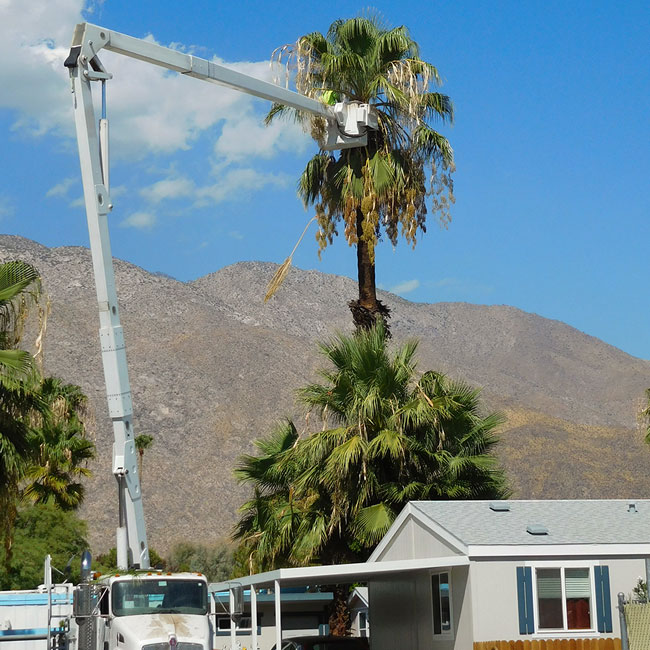
If you are not afraid of heights, you can rent a very tall ladder. Then use a regular pole saw or an electrical pole saw to trim the fronds.
Home Depot has extension ladders that extend up to 40 feet and cost around $50 per day for rent. I personally would not go higher than 15 ft.
For palms that are even taller, you can rent a truck with a telescoping basket, and a hydraulic lift with a basket on the end in which the tree trimmer stands. The lift brings the trimmer to the crown of the palm so that it can be pruned.
At this point, you might want to consider hiring a professional service that has all the necessary equipment and is used to working at height. Most palm owners that have very tall palms, get professional trimming service every other year.
Since all palms eventually shed their old leaves, decide how important dead leaf removal is to you. Renting a cherry picker can be expensive, and the reach of the lift may be inadequate for extremely tall palms.
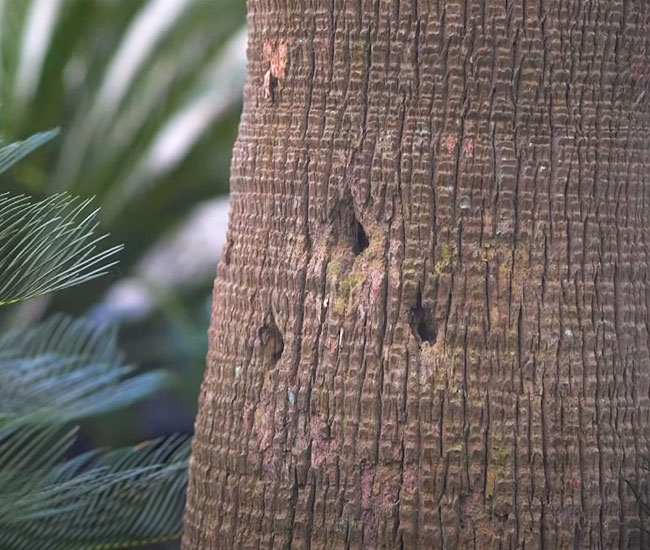
Another option is to hire a tree climber who will climb the palm to trim off old leaves. The problem with this option is that most tree climbers use boots with climbing spikes.
They climb by driving these spikes into the trunk as they get higher and in the process damage the palm. The holes left from spikes provide entry points for diseases and insects and can become permanent features.
Trimming Palm Tree Seed Pods and Flowers
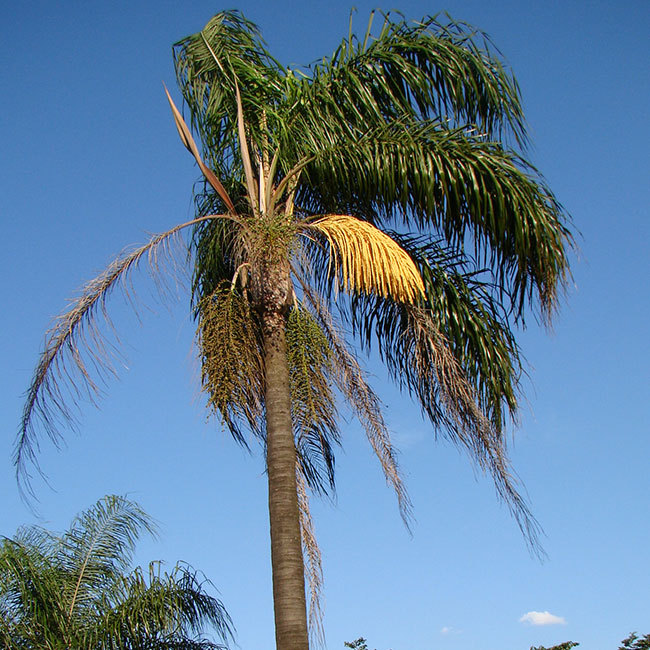
Depending on the species of the palm tree palm seeds can be edible or not edible. Seeds on some of the palms can even be toxic.
While it’s not necessary to trim off seed pods from palm trees, removing them will not harm the palm. Seeds that are toxic should definitely be removed. Btw, removing seed pods will not make palm trees grow faster although many believe that.
Also, you don’t need to prune flowers from the palm unless you are trying to avoid having to deal with the fruits. Most palm owners prefer to remove seed pods and flowers to avoid the mess they create in the yard.
When Should Palm Trees Be Pruned
While palms with yellow and brown fronds look unattractive, it’s best to remove palm leaves only after they have turned completely brown.
As the old leaf dies it moves nutrients to the newer fronds. By cutting off leaves that are not completely brown, you are robbing the tree of these nutrients.
In addition, as long as the leaf has some green in it, it can photosynthesize and produce new food for the tree. Repeated removal of green leaves can lead to pencil pointing, a condition in which the trunk becomes narrower and narrower at the top where the leaf crown forms.
The leaves become smaller as well. If excessive trimming continues the palm may never regain its health. However, partially green or yellow leaves can be quite unsightly.
You can safely remove dying leaves when they are more than 50% brown. Typically, it’s best to do it in the Spring during the growing season.
Trimming Newly Planted Palm Trees
If you drive around coastal areas during Spring time, you will notice a lot of newly planted palms with little or no leaves at all. Removal of most of the leaves is a common practice for minimizing water loss in in-ground-grown palms.
The main difference between container-grown palms and in-ground-grown palms is that in-ground-grown palms have their roots cut when dug and thus have a smaller root mass to absorb water. Because they need to regenerate new roots their water requirement is much greater than container-grown palms.
The greatest loss of water in newly dug in-ground-grown palms occurs from transpiration through the fronds. To decrease water stress, one-half or more of the leaves are removed at the time of the digging. The remaining leaves are then tied together in a bundle around the bud.
In some palm species like Sabal palms that have to regrow all of their roots after transplanting, it’s best to remove ALL of the leaves. This will ensure its survival and faster establishment especially if normal posttransplant irrigation is impossible.
How to Trim Palm Tree Trunk
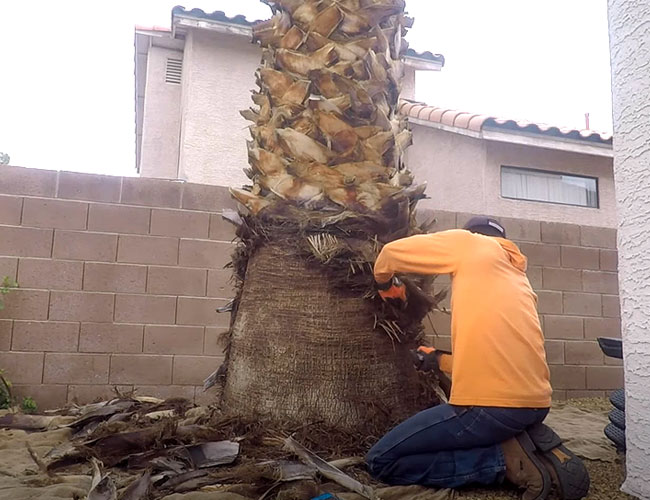
Many palms like Mexican Fan Palm or California Fan Palm, have trunks covered with old leaf bases which are left after old fronds have been removed or shed by the palm. Over time, those palms start to look ugly and messy.
Not only does it take several years for those old leaf bases to fall off on their own, but they also fall off unevenly creating an unattractive look.
That is why many homeowners prefer to skin the trunk instead of waiting. If you have a palm that has been neglected for a long time, pruning a palm trunk can be difficult and labor-intensive.
You will need:
- Heavy-duty gloves to protect your hand from sharp teeth, and insects.
- Goggles to protect your eyes from all the dust flying into your face.
- Face mask to protect yourself from dust and all kinds of debris trapped inside of the old leaf bases.
- Baseball hat or any other kind of hat to protect your head from falling debris.
- Utility knife that is used to cut carpet and a lot of blades.
Avoid using a chainsaw. While it looks like a much faster and easier way to remove the bases, it is also much easier to damage a trunk with it. A chainsaw is a very powerful tool that cuts fast and deep.
Like most professionals, I recommend using a regular utility knife that you would use to cut a carpet. Because old leaf bases overlap tightly in a crisscross pattern, it’s hard to remove one without removing the one below it. Starting at the bottom of the tree will allow you to remove them more effortlessly.
Start by skinning at the very bottom of the trunk slowly moving up. Try not to cut very deep into the trunk. You want to cut off the stems and slightly scratch the top surface of the trunk without damaging it. Making horizontal lines on the trunk that all go in the same direction will create a natural-looking pattern.
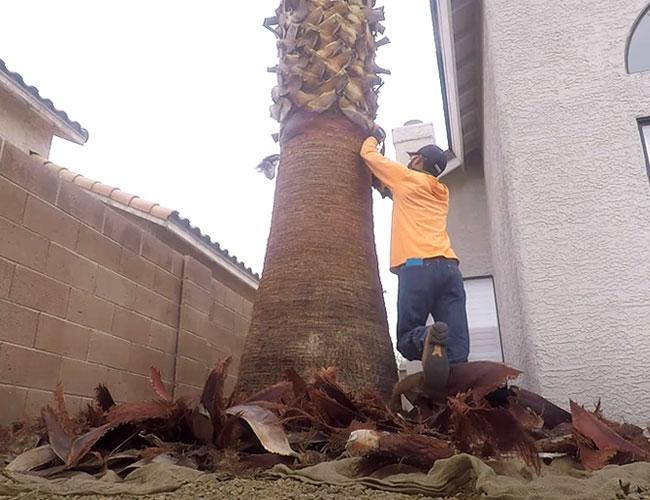
Because many homeowners like the reddish brown color of the trunk on Mexican Fan Palms, nurseries skin the trunk of the palm removing all the old bases and exposing the trunk before selling it.
One might think it was spray painted, but this is a natural color of the trunk that with time fades into gray.
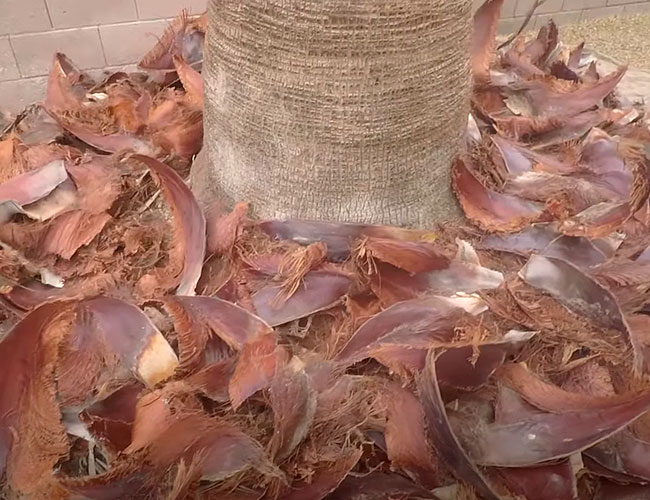
What Happens If You Don’t Trim Palm Trees
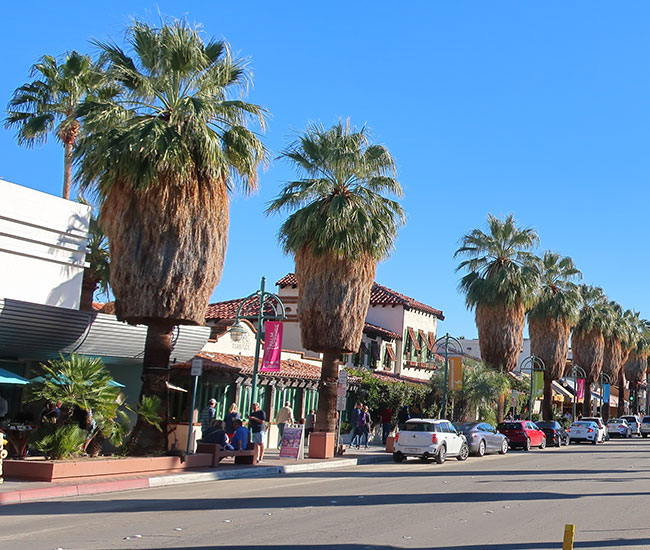
Whether or not palm trees should be trimmed depends on the species of the palm tree. Because all palms eventually shed their old leaves, you don’t have to trim them.
The petticoat of dead leaves on taller palms can even become an ornamental feature. Palms with a crown shaft do a great job cleaning themselves.
However, some palms require regular maintenance to avoid potential problems. Aside from a messy unattractive look, unpruned palms can catch on fire, topple over from a strong wind, or get infested with insects and rats.
Insect pests and palm rats love to live under dead fronds and in the old leaf bases on the trunk. Over time, palm rats can destroy your garden and find their way into your home.
Another problem is that dry fronds are quick to catch fire if there are wildfires nearby. The risk of fire increases if the tree is growing near electrical wires.
Strong winds can topple over an unpruned top-heavy palm and it can fall on top of your home or a car.
How Much Does It Cost To Get Palm Tree Pruned
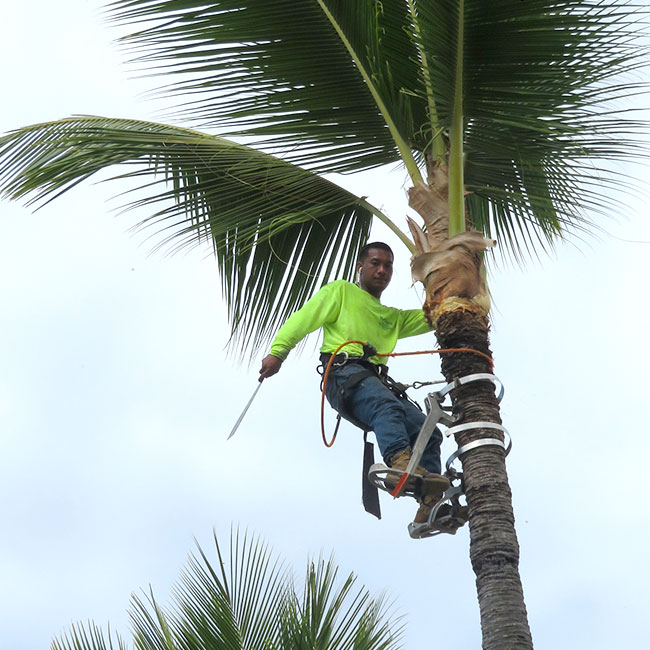
It depends on how many palm trees you have. If the company is bringing a crew with the lift trucks and you have only 2 palms, it won’t be worth their time or the cost might be high.
But, if you have 10 palms that need to be trimmed, it will probably be around $90-$150 per tree depending on how tall the palm is.
Most homeowners do it every other year. But if you have palms that are close to the pool area, you might have to trim them every year, to avoid fruits falling into the water.
Will a Palm Tree Die If You Cut The Top Off
Unlike broadleaf trees, palms are unable to heal themselves when it’s injured. All leaves of the palm are formed in the heart of the tree which is located near the top of the trunk. If you cut it off the palm will die because it cannot produce another one.
